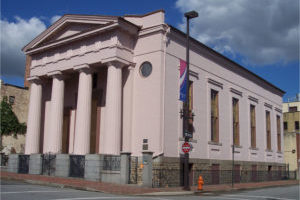Of Cisterns and Synagogues

Just when the archaeologists thought they were wrapping up the outside dig, they uncovered a fissure in the bottom of the pit. It is a crack, approximately six inches long by an inch wide, in a layer of granite blocks covering “a void beneath the unit floor,” according to archaeologist, Esther Read. Peter Middleton, the project lead, first tried to measure the depth with a six-foot measuring stick, but he was unable to reach the bottom of the hole. After attaching two measuring sticks together, he reached a depth of eight feet and encountered three to four feet of water before hitting a layer of silt. As of yet, the depth and volume have not been determined.
We do, however, have an idea about its purpose. During her first dig onsite (1999 – 2001), Esther speculated that there would be a cistern associated with the original mikveh. Because of the location of the “void,” we know that it pre-dates the expansion of the synagogue, which puts it in the correct time frame for Esther’s original speculation.
What does that mean for the renovation/restoration process? Well, immediately, it means more meetings. Over the next week, both the archaeology and grout injection will be put on hold until we can meet with the archaeologists, historic building specialists, and representatives from the Maryland Historical Trust. The long-term results remain to be seen.
